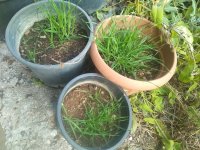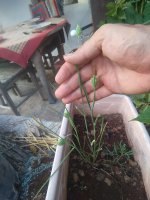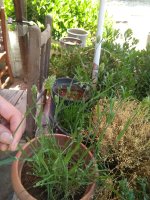Now I have at least two different strains of brachystachys, possibly three (two from a few hours apart of distance but with very similar morphology, another from farther away with a little different morphology), and also one strain of canariensis. I am wondering how much of a risk there is for cross pollination and hybridization between these different strains while growing in the same garden, and what exactly I must do to prevent this. Canariensis also hybridizes with brachystachys.
And a news. The seed dormancy period of my first harvest of brachystachys seems to be coming to an end and many new seedlings are popping up by the day the growth rate appears to be slower than I expected, some grass appearing to have stalled growth after a point. I wonder if this is related to the summer heat, despite my ample watering.
the growth rate appears to be slower than I expected, some grass appearing to have stalled growth after a point. I wonder if this is related to the summer heat, despite my ample watering.
And a news. The seed dormancy period of my first harvest of brachystachys seems to be coming to an end and many new seedlings are popping up by the day
 the growth rate appears to be slower than I expected, some grass appearing to have stalled growth after a point. I wonder if this is related to the summer heat, despite my ample watering.
the growth rate appears to be slower than I expected, some grass appearing to have stalled growth after a point. I wonder if this is related to the summer heat, despite my ample watering.


 This is huge indeed.
This is huge indeed.

 ,
,